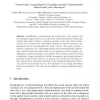Free Online Productivity Tools
i2Speak
i2Symbol
i2OCR
iTex2Img
iWeb2Print
iWeb2Shot
i2Type
iPdf2Split
iPdf2Merge
i2Bopomofo
i2Arabic
i2Style
i2Image
i2PDF
iLatex2Rtf
Sci2ools
ISMS
2004
Springer
2004
Springer
A Finite Element Study of the Influence of the Osteotomy Surface on the Backward Displacement during Exophthalmia Reduction
Exophthalmia is characterized by a protrusion of the eyeball. The most frequent surgery consists in an osteotomy of the orbit walls to increase the orbital volume and to retrieve a normal eye position. Only a few clinical observations have estimated the relationship between the eyeball backward displacement and the decompressed fat tissue volume. This paper presents a method to determine the relationship between the eyeball backward displacement and the osteotomy surface made by the surgeon, in order to improve exophthalmia reduction planning. A poroelastic finite element model involving morphology, material properties of orbital components, and surgical gesture is proposed to perform this study on 12 patients. As a result, the osteotomy surface seems to have a non-linear influence on the backward displacement. Moreover, the FE model permits to give a first estimation of an average law linking those two parameters. This law may be helpful in a surgical planning framework.
| Added | 02 Jul 2010 |
| Updated | 02 Jul 2010 |
| Type | Conference |
| Year | 2004 |
| Where | ISMS |
| Authors | Vincent Luboz, Annaig Pedrono, Dominique Ambard, Franck Boutault, Pascal Swider, Yohan Payan |
Comments (0)

